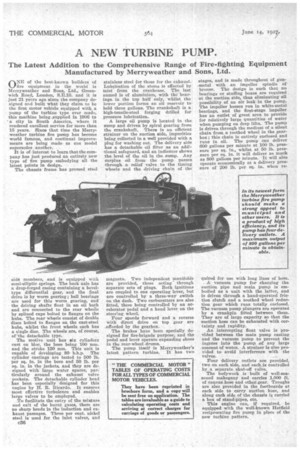A NEW TURBINE PUMP.
Page 58

If you've noticed an error in this article please click here to report it so we can fix it.
The Latest Addition to the Comprehensive Range of Fire-fighting Equipment Manufactured by Merryweather and Sons, Ltd.
OicE of the best-known builders of fire equipment in the world is Merryweather and Sons, Ltd., Greenwich Road. London, S.E.10. and it is just 21 years ago since the company designed and built what they claim to be the first motor vehicle equipped with a pump of the turbine type ever made, this machine being supplied in 1906 to
• a. city in South America. where it rendered excellent service for more than 15 years. Since that time the Merryweather turbine fire pump has become world famous, and continual improvements are being madeas one model supersedes another.
It is of interest to learn that the company has just produced an entirely new type of fire pump embodying all the latest points in design.
The chassis frame has pressed steel side members, and is equipped with semi-elliptic springs. The back axle has a drop-forged casing containing a beveltype differential gear, and the final drive is by worm gearing ; ball bearings are used for this worm gearing, and the driving shafts float in an oil bath and are connected to the rear wheels, by splined caps bolted to flanges on the hubs. The rear wheels consist of double discs bolted to flanges on the cast-steel hubs, whilst the front wheels each has a single disc. The wheels are, of course, of detachable type.
The motive -unit has six cylinders cast en bloc, the bore being 100 ram. and the stroke 130 min. This unit is capable of developing 80 b.h.p. The cylinder castings are tested to 500 lb. per sq. in. in the bore and 50 lb. per sq. in. in the jackets, and they are designed with large water spaces, particularly around the exhaust valve pockets. The detachable cylinder head has been especially designed for this engine by H. R. Ricardo. It ensures most effective turbulence and enables large valves to be employed.
To facilitate the entry of the mixture and exit of the burnt gases, there are no sharp bends in the 'induction and exhaust passages. Three per cent. nickel steel is used for the inlet valves, and 036 stainless steel for those for the exhaust. Lubrication of the stems is effected by mist from the crankcase. The last named is of aluminium, with the bearings in the top half only, whilst the lower portion forms an oil resevoir to hold three gallons. The crankshaft is a high-tensile-steel forging drilled for pressure lubrication.
A large oil pump is located in the sump and driven by spiral gearing from the crankshaft. There is an efficient strainer on the suction aide, impurities being collected in a well provided with a plug for washing out. The delivery side has a detachable oil filter as an additional safeguard, and an indicator shows the level of the oil in the sump. Any surplus oil from the pump passes through. a relief valve to the timing wheels and the driving chain of the magneto. Two independent manifolds are provided, these acting through separate sets of plugs. Both ignitions are coupled to one operating lever, hut are controlled by a three-way switch on the dash. Two carburetters are also fitted, these being controlled by an accelerator pedal and a hand lever on the steering wheel.
Four speeds forward and a reverse with direct drive on top gear are afforded by the gearbox.
The brakes have been specially designed for fire-brigade purpose, and the pedal and lever operate expanding shoes in the rear-wheel drums.
The pump itself is Merryweather's latest pattern turbine. It has two stages, and is made throughout of gun-metal with an impeller spindle of bronze. The design is such that no bearings or stuffing boxes are required. at the suction side, thus eliminating all possibility of an air leak in the pump. The impeller bosses run in white-metal bearings, and the first-stage impeller has an outlet of great area to provide for relatively large quantities of water when pumping on deep lifts. The pump is driven through the medium of a silent chain from a toothed wheel in the gearbox; this chain is entirely enclosed and runs in oil. The pump can deliver 600 gallons per minute at 100 lb. pressure per sq. in., whilst at 50 lb. pressure per sq. in. it will deliver as much as 800 gallons per minute. It will also operate economically at a delivery pressure of 200 lb. per sq. in. when re quired for use with long lines of hose.
A vacuum pump for charging the suction pipe and main pump is embodied as a unit with the latter, and is driven through a hand-operated friction clutch and a toothed wheel reduction gear which runs totally enclosed. The vacuum pump plungers are operated by ft crankpin fitted between them. They arc of large capacity so that the suction hose can be exhausted with certainty and rapidity.
An intercepting float valve is provided between the main pump casting and the vacuum pump to prevent the ingress into the pump a any large amount of water. A strainer is also provided to avoid interference with the valves.
Four delivery outlets are provided, two on each side, and each is controlled by a separate shut-off valve.
The bodywork is built of well-seasoned mahogany and carries 1,000 ft. of canvas hose and other gear. Troughs are also provided in the footboards at each side to carry suction hose, and along each side of the chassis is carried a box of stand-pipes, etc.
This engine can, if required, be equipped with the well-known Hatfield reciprocating fire pump in place of the new turbine pattern.












































































































